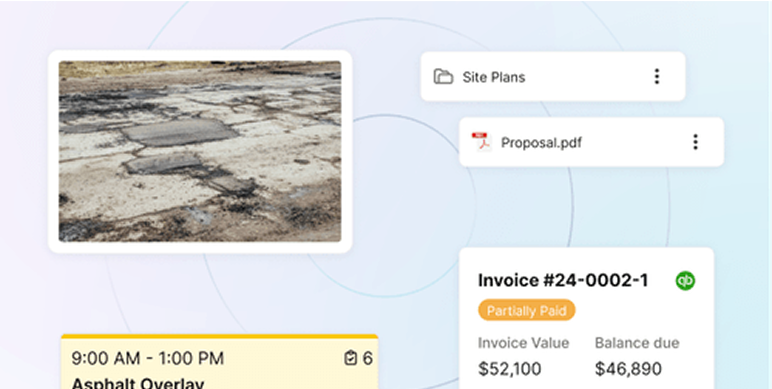Asphalt Penetration Test: A Complete Guide for 2025
Choose the wrong asphalt binder grade, and you're looking at rutted wheel paths in Atlanta's summer heat or spider-web cracks across Minnesota highways come January. These failures can trigger warranty claims, expensive repairs, and lost contracts.
The asphalt penetration test prevents these disasters by measuring exactly how hard or soft your binder is. This simple lab test determines whether your asphalt will flex without cracking in cold weather or stand firm against heavy trucks in scorching heat.
Contractors who skip proper penetration testing gamble with pavement life. This guide shows you exactly how penetration testing works and why those numbers matter for your bottom line.
What Is the Asphalt Penetration Test?
The asphalt penetration test is a standardized method that measures the hardness and consistency of asphalt binder by determining how far a weighted needle penetrates the material under controlled conditions.
This fundamental test helps engineers classify asphalt grades and predict pavement performance.
How does it measure binder properties?
The test quantifies asphalt binder hardness by measuring penetration depth in tenths of a millimeter (0.1 mm units). Harder binders resist penetration and produce lower values, typically ranging from 40 to 300, depending on the grade.
Material specifications use these values to ensure contractors select appropriate binders for different climates and traffic loads.
Temperature susceptibility is apparent through penetration testing at various temperatures. Softer binders with higher penetration values perform better in cold climates, where flexibility prevents cracking. Harder binders suit hot climates where resistance to rutting takes priority.
How the Asphalt Penetration Test Works
The penetration test relies on precision equipment and controlled conditions to deliver consistent, reproducible results that guide material selection across the industry.
Must-have equipment includes:
- Penetrometer device: The main testing apparatus that holds and releases the needle assembly
- Standard penetration needle: A hardened steel needle with specific dimensions (1 mm diameter tip)
- 100-gram weight assembly: Combined needle and plunger weight totaling exactly 100 grams
- Water bath: Maintains sample temperature at 25°C (77°F) throughout testing
- Sample containers: Flat-bottomed metal containers for holding test specimens
- Timer: Measures the exact 5-second penetration period
- Thermometer: Monitors bath temperature to ensure ±0.1°C accuracy
Standard test conditions confirm reliable results:
- Temperature: 25°C (77°F) maintained consistently
- Load: 100-gram total weight on the needle
- Duration: 5-second penetration period
- Sample depth: Minimum 15 mm of asphalt in the container
Key terminology explained
Penetration value represents the depth in deciseconds of a millimeter (dmm) that the needle penetrates. A reading of 85 means the needle penetrated 8.5 millimeters into the sample. The industry often drops “dmm” and simply refers to “85 pen” asphalt.
Penetration grade classifies binders based on their penetration range. Common grades include 40–50, 60–70, and 85–100, where numbers indicate the penetration range for that grade.
Asphalt Penetration Test Procedure
Proper technique and careful sample preparation determine whether your test results accurately reflect binder properties for mix design and quality control. Step-by-step lab procedure:
- Prepare the sample: Heat the asphalt to pouring temperature. This should not exceed 90°C above the softening point, and typically ranges 125–140°C for standard grades. Then, pour it into containers.
- Condition specimens: Cool samples at room temperature for 1–1.5 hours, then place in a 25°C (77°F) water bath for another 1–1.5 hours.
- Level the penetrometer: Make sure the device sits perfectly level using the built-in bubble levels.
- Position the needle: Lower the needle until it barely touches the asphalt surface, visible in the sample's reflection.
- Zero the dial gauge: Set the penetration measurement dial to zero.
- Release the needle: Press the release button to drop the needle for exactly 5 seconds.
- Record the reading: Note the penetration depth from the dial gauge.
- Repeat testing: Perform at least three penetrations, each 10 mm apart from container edges and other penetration points.
- Calculate average: Report the mean of three acceptable readings as the penetration value.
Sample preparation requirements include filtering hot asphalt through a 300-micron sieve to remove contaminants and avoiding air bubble incorporation during pouring. Samples must reach thermal equilibrium before testing begins.
Common errors to avoid:
- Testing at incorrect temperatures destroys result validity
- Dirty needles create friction and reduce penetration readings
- Vibrations during testing affect needle movement
- Insufficient sample depth leads to boundary effects
- Multiple penetrations too close together influence subsequent readings
Note: For more on pavement testing procedures, explore our guide on the Marshall Test for mix design verification.
Understanding the Results
High penetration values (150–300) indicate softer binders that remain flexible in cold temperatures. These materials resist thermal cracking, but may rut under heavy traffic in hot weather.
Low penetration values (40–60) mean harder binders that maintain stability at high temperatures. Hot climates and heavy traffic areas benefit from these grades, though they may crack in cold conditions without modification.
Ideal ranges vary by application:
- Residential driveways: 85–100 penetration grade balances durability with flexibility
- Highway surfaces: 60–70 grade resists rutting from heavy trucks
- Airport runways: 40–50 grade withstands extreme loads and jet fuel exposure
- Cold climate roads: 120–150 grade prevents winter cracking
Mix design engineers use penetration values alongside other asphalt binder testing results to optimize performance. The penetration grade influences mixing temperatures, compaction requirements, and expected service life.
Note: Understand how penetration values relate to density measurements in our post about Asphalt Rice Number calculations.
Asphalt Testing Requirements and Standards
Industry standards guarantee consistent asphalt test procedures across laboratories, enabling reliable material specifications and quality control programs nationwide.
ASTM D5-06 provides the standard penetration test method used throughout North America. The procedure specifies equipment calibration, sample preparation, and reporting requirements that ensure reproducible results.
AASHTO T 49 offers an equivalent standard that many state departments of transportation reference in their specifications. Both standards produce comparable results when followed correctly.
Project specifications typically require penetration testing during:
- Mix design approval: Verifying binder grade before production begins
- Material certification: Confirming delivered asphalt meets specifications
- Quality assurance: Random testing during production
- Forensic analysis: Investigating pavement failures or premature distress
Complete binder characterization combines penetration results with additional tests. Softening point indicates temperature susceptibility, ductility measures stretching ability before breaking, and viscosity quantifies flow resistance at mixing temperatures.
Together, these properties predict field performance better than any single test.
State specifications often mandate specific penetration grades based on regional climate data and traffic patterns. Contractors must verify compliance through certified laboratory testing before beginning paving operations.
Note: Plan your testing schedule alongside our Asphalt Maintenance Schedule recommendations for optimal pavement management.
Limitations of Penetration Tests
Despite widespread use, the asphalt penetration test procedure has recognized limitations that engineers must consider when evaluating binder properties. Key limitations include:
- Single temperature assessment: Testing at 25°C (77°F) doesn't capture performance across the full temperature range that pavements experience
- Empirical nature: Results don't directly relate to fundamental material properties or field performance mechanisms
- Polymer-modified binder issues: Modified asphalts may show similar penetration values but perform differently due to polymer networks
- Loading rate sensitivity: The 5-second test duration doesn't reflect actual traffic loading patterns
- Temperature susceptibility gaps: Two binders with identical penetration values may behave differently at temperature extremes
- Aging effects: Penetration changes over time, but the test doesn't predict aging rates
Performance-graded (PG) specifications address these limitations through dynamic shear rheometer and bending beam rheometer tests that better predict field behavior.
Many agencies now require PG grading alongside traditional penetration testing for comprehensive characterization.
Note: Learn about equipment considerations in our paving machinery guide and maintenance best practices in our asphalt maintenance article.
Simplify Your Asphalt Projects with OneCrew
Managing test results, field operations, and quality documentation across multiple projects creates complexity that slows you down. OneCrew simplifies these workflows with tools built specifically for paving contractors.
Here's why contractors choose OneCrew for managing projects that require rigorous asphalt testing requirements:
- Built for paving workflows: OneCrew understands the connection between lab testing, mix design, and field placement, helping you track specifications and test results by project
- Faster documentation: Upload penetration test reports, mix designs, and quality control data directly to project files where crews and inspectors can access them instantly
- Configurable quality checklists: Create inspection forms that match your testing protocols, from sampling schedules to acceptance criteria
- Integrated communication: Share asphalt test results with project stakeholders through the customer portal, ensuring everyone sees the same verified data
- Simplified compliance tracking: Organize material certifications, test reports, and project specifications in one searchable system
Book a free demo today to see how OneCrew helps paving contractors coordinate testing requirements, field operations, and quality documentation from estimate to final invoice.
FAQs
1. What are typical penetration values for asphalt binders?
Typical penetration values for asphalt binders range from 40 to 300 dmm, with most paving grades falling between 60 and 120 dmm. Common grades include 60 to 70 dmm for highways, 85 to 100 dmm for local roads, and 120 to 150 dmm for cold climates.
2. What are the limitations of the asphalt penetration test?
The asphalt penetration test's main limitations include testing at only one temperature, inability to predict polymer-modified binder performance, and lack of correlation with actual traffic loading. The empirical results don't directly indicate fundamental material properties or aging characteristics.
3. How does penetration testing compare to viscosity testing?
Penetration testing measures hardness at 25°C (77°F) through needle penetration, providing a simple classification method. Viscosity testing measures flow resistance at mixing and compaction temperatures, offering better correlation with construction workability. Both tests complement each other in comprehensive asphalt binder testing programs.
4. When is the asphalt penetration test required?
The asphalt penetration test is required during mix design approval, material certification before delivery, production quality control, and failure investigations. Project specifications typically mandate testing frequency based on tonnage or time intervals.
5. Who performs asphalt penetration testing?
Certified laboratories perform asphalt penetration testing, including material suppliers' quality control labs, independent testing firms, and state DOT facilities. Technicians must follow ASTM or AASHTO procedures and maintain equipment calibration for valid results.
6. What do penetration test results mean for pavement design?
Penetration test results guide binder grade selection to match climate conditions and traffic loads for optimal pavement life. Lower penetration values suit hot climates and heavy traffic, preventing rutting. Higher values provide flexibility in cold regions, reducing thermal cracking potential.


